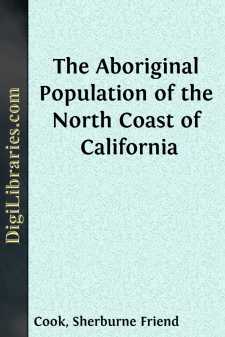Categories
- Antiques & Collectibles 13
- Architecture 36
- Art 48
- Bibles 22
- Biography & Autobiography 813
- Body, Mind & Spirit 142
- Business & Economics 28
- Children's Books 14
- Children's Fiction 11
- Computers 4
- Cooking 94
- Crafts & Hobbies 4
- Drama 346
- Education 46
- Family & Relationships 57
- Fiction 11829
- Games 19
- Gardening 17
- Health & Fitness 34
- History 1377
- House & Home 1
- Humor 147
- Juvenile Fiction 1873
- Juvenile Nonfiction 202
- Language Arts & Disciplines 88
- Law 16
- Literary Collections 686
- Literary Criticism 179
- Mathematics 13
- Medical 41
- Music 40
- Nature 179
- Non-Classifiable 1768
- Performing Arts 7
- Periodicals 1453
- Philosophy 64
- Photography 2
- Poetry 896
- Political Science 203
- Psychology 42
- Reference 154
- Religion 513
- Science 126
- Self-Help 84
- Social Science 81
- Sports & Recreation 34
- Study Aids 3
- Technology & Engineering 59
- Transportation 23
- Travel 463
- True Crime 29
The Aboriginal Population of the North Coast of California
Description:
Excerpt
INTRODUCTION
The present manuscript attempts a reassessment of the aboriginal population of Northwestern California, from the Oregon line to the Bay of San Francisco. There are no natural and fixed limits to the territory. Its outline serves merely the purposes of convenience. For this reason the individual units within the whole area are based, not upon natural ecological provinces such as mountain ranges, valleys, or river basins, but upon ethnic or "tribal" boundaries. Moreover, since there is no necessary interrelationship between the component parts, each is considered as a separate entity, and its population is computed separately. There is no final grand total to be added up, the significance of which transcends that of any of the constituents.
Since the objective here is the calculation of pure numbers, it is irrelevant that the natural habitat, the mode of life, the reactions to environment of the various tribes and linguistic stocks vary enormously. Such a disregard for the basic principles of ethnography and human ecology will be tolerated only because the limitations of space and time demand that the fundamental question "What was the population?" be answered before opening up the problem of why the population was no greater or no less. We must know how many people there were before we can study their equilibrium with the physical or cultural environment.
The outcome of this study is to augment markedly the previously estimated number of inhabitants in the region at hand, and, by implication, the number in the whole state. The magnitude of the aboriginal population has steadily diminished in our eyes for many years. I believe it was Powers who thought that the natives numbered as high as 750,000 or more. Merriam thought there were 260,000. Kroeber, in the Handbook of California Indians, (1925, p. 882) reduced it to 133,000. I myself in an earlier work (1943, pp. 161 et seq.) reviewed the evidence and raised Kroeber's figure by no more than 10 per cent. It appears to me that the trend toward assessing the native population in continually diminishing terms is due to the operation of two factors.
The first is a tendency on the part of subsequent generations to adopt a highly skeptical attitude toward all statements and testimony derived from earlier generations. Inherent in this point of view is the feeling, consciously expressed or unconsciously followed, that all human beings contemporary with an event either lie deliberately or exaggerate without compunction. This failing, so the argument runs, becomes most apparent when any numerical estimates are involved. Thus the soldier inevitably grossly magnifies the force of the enemy, the priest inflates the number of his flock, the farmer falsifies the size of his herds, the woodsman increases the height of the tree—all just as the fisherman enlarges upon the big one which got away. That these individuals are frequently subject to an urge to exaggerate cannot for a moment be denied. Nevertheless, under many circumstances most men lack a desire to do so or, if they feel such desire, know how to curb it....


